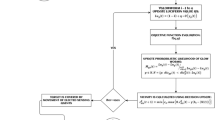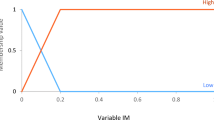Abstract
Recent evolutions of MEMS technology, digital electronics, and wireless communication technologies have made smart environments possible; especially through the apparition or incorporation of sensors. Despite being small-sized, the sensors have paved the way for data collection in the environments where they are applied; including luminosity, gas presence, water content, humidity, pressure, and temperature. This research aims to pragmatically optimize Wireless Sensor Network Localization and Network Coverage issues using nature-inspired algorithms. The specific objective is to establish an optimal nature-inspired algorithm and comparing it with other algorithms regarding the capacity to achieve manufacturing optimization in large WSNs, especially in relation to the parameters of high scalability, data delivery rate, and low-energy consumption. Also, the study seeks to determine the extent to which swarm intelligence (SI)-based centralized clustering solutions (optimal nature-inspired algorithms), compared to other approaches, might optimize the WSN features of localization and network coverage. To determine the solutions’ performance, the study involved three scenarios. In scenario 1, the network operational time and the stability of SI-based algorithms were investigated for large WSNs that had the minimum heterogeneity. Imperative to note is that the WSNs on focus had different numbers of nodes, which included 500, 300, and 100. In scenario 2, the motivation was to investigate the SI-based WSN protocols in relation to the parameters of packet delivery, energy conception, and network lifetime for large WSNs. In scenario 3, the performance of SI-based solutions over large WSNs was compared to that which had been reported previously for other algorithms; with the target parameters of comparison being attributes such as packet delivery, energy conception, and network lifetime. From the findings, this study established that SI-based centralized clustering solutions are not only more recent but also exhibit superior performance compared to other algorithms; with the parameters of the amount of data delivered to the BS, energy consumption and scalability on the focus.



Similar content being viewed by others
References
Abdullah, M., & Ehsan, A. (2015). Routing protocols forwireless sensor networks: Classifications and challenges. Journal of Electronics and Communication Engineering Research, 2, 5–15.
Alkandari, A., Alnasheet, M., & Alshaikhli, I. F. T. (2012). Smart cities: A survey. Journal of Advanced Computer Science and Technology Research (JACSTR), 2(2), 79–90.
Ari, A. A., Yenke, B. O., Labraoui, N., Damakoa, I., & Gueroui, A. (2016). A power efficientcluster-based routing algorithm for wireless sensor networks: Honeybees swarm intelligence based approach. Journal of Network and Computer Applications, 69, 77–97.
Arya, A., Malik, A., & Garg, R. (2013). Reinforcement learning based routing protocols in WSNs: A survey. International Journal of Computer Science Engineering and Technology, 4, 1401–1404.
Aziz, A., Sekercioglu, Y., Fitzpatrick, P., & Ivanovich, M. (2013). A survey on distributed topology control techniques for extending the lifetime of battery powered wireless sensor networks. 1st 2013 IEEE communications surveys tutorials, (vol. 15, No. 1, pp. 121–144).
Bhanderi, M., & Shah, H. (2014). Machine learning for wireless sensor network: A review challenges and applications. Advances in Electronic and Electrical Engineering, 4, 475–486.
Elhabyan, R. S., & Yagoub, M. C. E. (2015). Two-tier particle swarm optimization protocol for clustering and routing in wireless sensor network. Journal of Network and Computer Applications, 52, 116–128.
Guo, W., Zhang, W., & Lu, G. (2010). A comprehensive routing protocol in wireless sensor network based on ant colony algorithm. 2010 2nd International conference on networks security wireless communications and trusted computing (NSWCTC), IEEE, (vol. 1).
Hao, L., Wang, Y., Liangping, T., et al. (2019). A modified particle swarm optimization for large-scale numerical optimizations and engineering design problems. Journal of Intelligent Manufacturing, 30(6), 2407–2433.
Jeevan, K., & Sachin, T. (2016). A survey on routing protocols for wireless sensor networks using swarm intelligence. International Journal of Internet Technology and Secured Transactions, 6, 79–102.
Kumar, A. G. G., Thiyagarajan, R., & Sripriya, N. (2014). Data centric based routing protocols for wireless sensor networks: A survey. International Journal of Scientific and Research Publications, 4, 1–5.
Libin, Han, Keyi, Xing, Xiao, Chen, & Fuli, Xiong. (2018). A Petri net-based particle swarm optimization approach for scheduling deadlock-prone flexible manufacturing systems. Journal of Intelligent Manufacturing, 29(5), 1083–1096.
Mousavi, S. M., Alikar, N., Tavana, M., et al. (2019). An improved particle swarm optimization model for solving homogeneous discounted series-parallel redundancy allocation problems. Applied Intelligence, 30, 1175–1194.
Mundada, M. R., Kiran, S., Khobanna, S., Varsha, R. N., & George, S. A. (2012). A study on energy efficient routing protocols in wireless sensor networks. International Journal of Distributed and Parallel Systems (IJDPS), 3, 311–330.
Munot, H., & Kulkarni, P. H. (2016). Survey on computational intelligence based routing protocols in WSN. International Journal of Research in Engineering and Technology, 3, 122–127.
Oppermann, F. J., Boano, C. A., Römer, K. (2014). A decade of wireless sensing applications: Survey and taxonomy. In The Art of Wireless Sensor Networks (pp. 11–50). Springer.
Pitchaimanickam, B., & Radhakrishnan, S. (2014). A hybrid bacteria foraging using Particle Swarm Optimization algorithm for clustering in wireless sensor networks. 2014 International conference on science engineering and management research (ICSEMR), IEEE.
Sabor, N., Sasaki, S., Abo-Zahhad, M., & Ahmed, S. M. (2017). A comprehensive survey on hierarchical-based routing protocols for mobile wireless sensor networks: Review, taxonomy, and future directions. Wireless Communications and Mobile Computing, 2017, 1–23.
Saleh, S., et al. (2014). A survey on energy awareness mechanisms in routing protocols for wireless sensor networks using optimization methods. Transactions on Emerging Telecommunications Technologies, 25(12), 1184–1207.
Sirsikar, S., & Wankhede, K. (2015). Comparison of clustering algorithms to design new clustering approach. Procedia Computer Science, 49, 147–154.
Solaiman, B., & Sheta, A. (2013). Computational intelligence for wireless sensor networks: Applications and clustering algorithms. International Journal of Computers and Applications, 73, 1–8.
Yenke, B. O., Wohwe Sambo, D., Adamo Ado, A. A., & Gueroui, A. (2016). MMEDD: Multithreading model for an efficient data delivery in wireless sensor networks. International Journal of Communication Networks and Information Security, 8, 179–186.
Zungeru, A. M., Ang, L.-M., & Seng, K. P. (2012). Classical and swarm intelligence based routing protocols for wireless sensor networks: A survey and comparison. Journal of Network and Computer Applications, 35(5), 1508–1536.
Author information
Authors and Affiliations
Corresponding author
Additional information
Publisher's Note
Springer Nature remains neutral with regard to jurisdictional claims in published maps and institutional affiliations.
Rights and permissions
About this article
Cite this article
Mahapatra, C., Payal, A. & Chopra, M. Swarm intelligence based centralized clustering: a novel solution. J Intell Manuf 31, 1877–1888 (2020). https://doi.org/10.1007/s10845-020-01542-9
Received:
Accepted:
Published:
Issue Date:
DOI: https://doi.org/10.1007/s10845-020-01542-9




